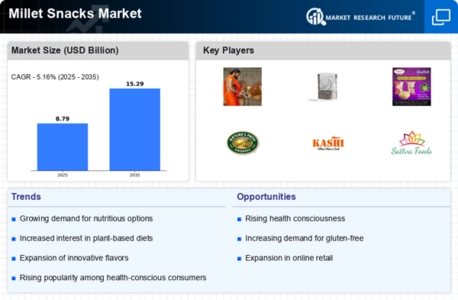The Millet Snacks Market is currently characterized by a dynamic competitive landscape, driven by increasing consumer demand for healthy and nutritious snack options. Key players are actively engaging in various strategies to enhance their market presence and cater to evolving consumer preferences. Notably, companies such as Patanjali Ayurved (IN), Kashi (US), and Nature's Path Foods (CA) are focusing on product innovation and regional expansion to solidify their positions. Patanjali Ayurved (IN) emphasizes traditional health benefits, while Kashi (US) leverages its strong brand identity in the health food sector. Nature's Path Foods (CA) is committed to organic and sustainable practices, which resonate well with environmentally conscious consumers. Collectively, these strategies contribute to a competitive environment that is increasingly focused on health, sustainability, and consumer engagement.
In terms of business tactics, companies are localizing manufacturing and optimizing supply chains to enhance efficiency and reduce costs. The Millet Snacks Market appears moderately fragmented, with several players vying for market share. This fragmentation allows for niche brands to emerge, catering to specific dietary needs and preferences. The collective influence of key players is significant, as they set trends that smaller companies often follow, thereby shaping the overall market structure.
In August 2025, Kashi (US) launched a new line of millet-based snack bars, which are designed to appeal to health-conscious consumers seeking convenient options. This strategic move not only diversifies Kashi's product portfolio but also aligns with the growing trend of incorporating ancient grains into modern diets. The introduction of these snack bars is likely to enhance Kashi's competitive edge in the health snack segment, potentially attracting a broader customer base.
In September 2025, Nature's Path Foods (CA) announced a partnership with local farmers to source organic millet, reinforcing its commitment to sustainability and community support. This initiative not only strengthens its supply chain but also enhances brand loyalty among consumers who prioritize ethical sourcing. By investing in local agriculture, Nature's Path Foods (CA) positions itself as a leader in the sustainable snack market, which could lead to increased market share in the coming years.
In July 2025, Patanjali Ayurved (IN) expanded its distribution network by entering new international markets, particularly in Europe and North America. This strategic expansion is indicative of Patanjali's ambition to become a global player in the health food sector. By tapping into these markets, Patanjali aims to leverage the growing interest in millet-based products, which are perceived as healthy alternatives to conventional snacks.
As of October 2025, the Millet Snacks Market is witnessing trends such as digitalization, sustainability, and the integration of artificial intelligence in product development and marketing strategies. Strategic alliances among companies are increasingly shaping the competitive landscape, allowing for shared resources and knowledge. Looking ahead, competitive differentiation is likely to evolve, with a shift from price-based competition to a focus on innovation, technology, and supply chain reliability. Companies that can effectively leverage these trends will likely secure a more robust position in the market.



.webp)
.webp)
.webp)
.webp)
.webp)
.webp)








Leave a Comment